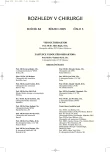-
Medical journals
- Career
Intraperitoneal Placement of Composite Material – Polyester Mesh with Coat of Polyurethane in Experimental Study
Authors: M. Chobola 1; Z. Vobořil 1; D. Hadži Nikolov 2
Authors‘ workplace: Chirurgická klinika FN a LF UK, Hradec Králové, přednosta prof. MUDr. Z. Vobořil, DrSc. 1; Fingerlandův patologicko-anatomický ústav FN a LF UK, Hradec Králové přednosta prof. MUDr. I. Šteiner, CSc. 2
Published in: Rozhl. Chir., 2005, roč. 84, č. 3, s. 128-133.
Category: Monothematic special - Original
Overview
Introduction:
Polyester and polypropylene are currently the most frequently materials for repair of abdominal wall hernias. Most of the mesh materials used intraperitoneally in repair of hernias lead to considerable adhesion formation, as well as the resultant bowel obstruction and intestinal fistula formation. Some newer composite products can reduce risk of adhesion formation. The aim of this experimental study is testing properties of patch, composite structure, characterised by the association of a non-woven textile structure made from polyester multifilaments, and a fine coat of polyurethane on one side, placed intraperitoneally in rat.Materials and methods:
The experiment was carried out with 21 laboratory rats. Laboratory animals were divided into 3 groups – 7 animals in a group. In the first group the check-up laparotomy was realized the 7th day, in the second group the 14th day and in the third group the 28th day after the intraperitoneal implantation of a composite mesh. All animals were sacrificed and adhesion scoring and histological evaluation of tissue specimens with implanted mesh were done.Results:
Amacroporous polyester mesh component supported an early and huge fibrous proliferation with a good adhesion onto the abdomen wall. On the other hand, a microporous polyurethane layer led to the creation of a fibrous pocket. During the check-up laparotomy, the larger adhesion of omentum to the fibrous layer, covering the polyurethane side of implanted mesh, were located in most laboratory rats – in all the groups.Conclusion:
We can presume that the protective polyurethane layer does not eliminate risk of adhesion formation in rat.Key words:
hernia – polyester – polyurethan – composite material – intraperioneal implantation – adhesion formation
Labels
Surgery Orthopaedics Trauma surgery
Article was published inPerspectives in Surgery

2005 Issue 3-
All articles in this issue
- An Inflammatory Aneurysm of the Abdominal Aorta
- Sentinel Node Biopsy in Breast Cancer. Technique and Indication – Standard of Care
- Acute Bleeding in the Crohn’s Disease
- Intraperitoneal Placement of Composite Material – Polyester Mesh with Coat of Polyurethane in Experimental Study
- Impact of Various Types of Artificial Nutrition on Postoperative Complications after Major Surgery of Upper Gastrointestinal Tract
- Implantations of Venous Ports – the Latest Advances
- The Malignant Melanoma Metastasis into the Stomach Corpus
- Transplantation of the Lung Lobe
- Perspectives in Surgery
- Journal archive
- Current issue
- Online only
- About the journal
Most read in this issue- Implantations of Venous Ports – the Latest Advances
- Acute Bleeding in the Crohn’s Disease
- The Malignant Melanoma Metastasis into the Stomach Corpus
- An Inflammatory Aneurysm of the Abdominal Aorta
Login#ADS_BOTTOM_SCRIPTS#Forgotten passwordEnter the email address that you registered with. We will send you instructions on how to set a new password.
- Career

